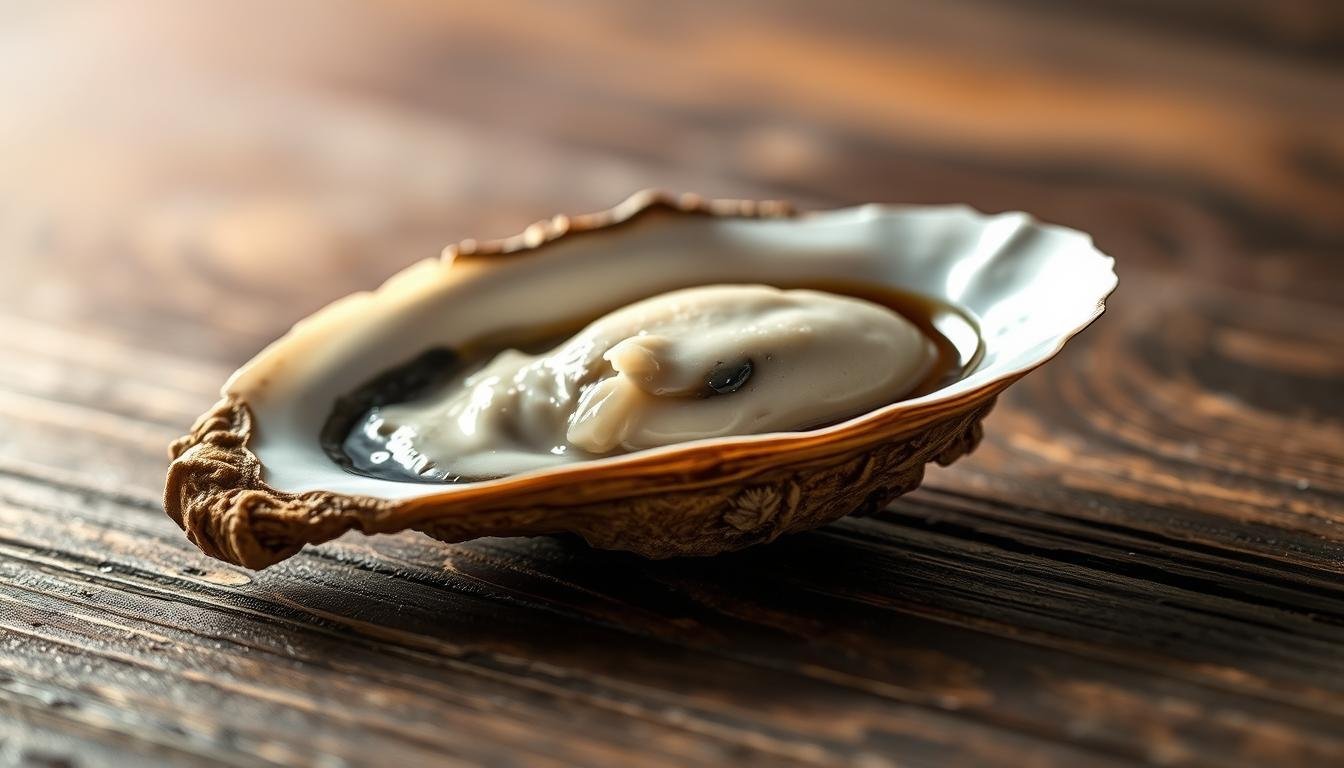Eating Dead Oysters: Many people enjoy eating oysters, but it’s important to know the dangers of eating dead oysters. It’s a big concern for those who eat out at seafood places or buy oysters at markets.
Oyster safety isn’t just about where they come from. It’s also about their condition. Dead oysters can harbor harmful bacteria. Knowing the risks and taking steps to avoid them can help keep you safe from foodborne illnesses.
Let’s dive deeper into how to eat oysters safely. We’ll look at how to spot fresh oysters, the right way to store them, and the dangers of eating them when they’re not fresh.
Contents
- 1 Understanding Oysters and Their Lifecycle
- 2 Can You Eat Dead Oysters? The Straight Answer
- 3 How to Identify Dead Oysters
- 4 Health Risks Associated with Eating Dead Oysters
- 5 Purchasing and Handling Oysters Safely
- 6 Cooking Considerations for Questionable Oysters
- 7 Oyster Safety: Making Informed Choices
- 8 FAQ: Eating Dead Oysters
- 8.1 What are the signs that an oyster is dead?
- 8.2 Can cooking dead oysters make them safe to eat?
- 8.3 How should I store oysters to keep them fresh?
- 8.4 What are the health risks associated with eating dead oysters?
- 8.5 How can I check oysters for freshness when purchasing them?
- 8.6 Are there any specific guidelines for cooking oysters to ensure they are safe to eat?
Understanding Oysters and Their Lifecycle
Learning about oysters’ lifecycle helps us see their importance in the ocean and as food. They go through many stages, from tiny larvae to full-grown adults. Each stage is key for their survival and for harvesting.
In summer, oysters release larvae that float in the water. These larvae then settle on surfaces and start growing. As they grow, they filter the water, making it cleaner.
How Oysters Are Harvested
Oysters are usually picked up by dredging or by hand. Dredging uses a metal frame to scoop them up from the seabed. Hand-picking is more careful and done in shallower waters. The way they’re picked can affect their quality and safety.
After being picked, oysters are sorted, cleaned, and shipped to markets. How they’re handled and stored can greatly impact their freshness and safety.
Knowing how oysters are harvested and handled helps us understand the risks of eating dead ones. It also helps us make better choices about eating them.
Can You Eat Dead Oysters? The Straight Answer
Eating dead oysters can be very dangerous. When oysters die, they become a perfect place for harmful bacteria to grow. This includes Vibrio vulnificus, which can cause serious food poisoning.
Dead oysters can make you sick in many ways. You might feel just a little off, or it could be very serious. People with weak immune systems, like the elderly or pregnant women, are at the highest risk.
- Food poisoning from bacteria like Vibrio vulnificus and Salmonella
- Gastrointestinal symptoms such as nausea, vomiting, and diarrhea
- Severe infections that can spread beyond the gastrointestinal tract
To stay safe, always check if oysters are fresh before eating them. If you’re not sure if an oyster is good to eat, it’s better to throw it away.
How to Identify Dead Oysters
Knowing how to spot dead oysters is key for safe eating. Whether you’re at the market or cooking at home, checking for freshness is essential.
Checking Oysters for Freshness
Here are signs to look for to tell if an oyster is dead:
- A broken or cracked shell
- An oyster that is open and does not close when tapped
- A strong, unpleasant odor
- A shell that is unusually heavy or light
Inspecting oysters carefully before eating can help avoid food poisoning. Here’s how to check:
- Tap oysters that are open; they should close if alive.
- Check for any visible damage to the shell.
- Smell the oyster; fresh ones should have a mild, salty smell.
By following these steps, you can enjoy safe and tasty oysters. Always choose caution and throw out any questionable oysters.
Health Risks Associated with Eating Dead Oysters
Dead oysters can be a breeding ground for harmful bacteria. This makes them dangerous to eat. When oysters die, their bodies can become contaminated with pathogens. Vibrio vulnificus, a bacterium, is one of these pathogens that can cause severe illness in humans.
Consuming dead oysters contaminated with Vibrio vulnificus can lead to food poisoning. Symptoms include vomiting, diarrhea, and abdominal pain. People with weakened immune systems are especially vulnerable to these infections.
Other bacteria and pathogens can also grow in dead oysters. These include other Vibrio species and bacterial contaminants. They can cause a range of gastrointestinal symptoms.
To minimize the risk of food poisoning from oysters, it’s crucial to handle and store them properly. Always check for signs of freshness. Avoid consuming oysters that have been dead for an unknown period.
In summary, eating dead oysters can expose you to significant health risks, primarily due to bacterial contamination. Being aware of these risks and taking appropriate precautions when handling oysters is essential for safe consumption.
Purchasing and Handling Oysters Safely
To enjoy oysters safely, knowing how to buy and handle them is key. Start by buying from trusted sources. These places follow strict quality and hygiene rules, lowering the chance of getting sick.
When you buy oysters, check for signs of freshness. Look for closed shells or a smell that reminds you of the ocean. Stay away from oysters with broken shells or those that won’t close when tapped.
Storing Oysters Properly
Keeping oysters fresh and safe is important. Store them in a covered container with a damp cloth. Make sure they’re in the fridge at a temperature below 40°F (4°C). Don’t put them in airtight containers or soak them in water.
| Storage Method | Temperature | Duration |
|---|---|---|
| Refrigerated | Below 40°F (4°C) | Up to a week |
| On ice | Near 32°F (0°C) | Up to 2 weeks |
By following these tips, you can enjoy oysters safely. Always check local advice on handling oysters safely and storing oysters right.
Cooking Considerations for Questionable Oysters
Cooking methods can greatly affect oyster safety. If you’re not sure about the oysters’ freshness, cooking them right is key. This ensures you avoid health risks. It’s important to know the right temperatures and cooking times.
Cooking oysters until they open fully and are hot through can kill harmful bacteria. Cooking them at a high temperature, above 145°F (63°C), is recommended. Also, make sure they cook for enough time, until their shells open.

If you’re still unsure about your oysters after cooking, it’s safer to throw them away. Questionable oysters can lead to serious health issues, like food poisoning from Vibrio vulnificus. Always choose caution when in doubt.
To enjoy oysters safely, follow proper cooking practices. Be careful with oysters that are old or handled badly. By being careful with how you cook and handle oysters, you can avoid health risks.
Oyster Safety: Making Informed Choices
It’s important to know the risks of eating dead oysters to enjoy them safely. Knowing how to spot dead oysters and understanding health risks can help avoid foodborne illnesses.
When buying oysters, make sure they are handled and stored right. This keeps them fresh and safe. If you’re not sure about an oyster’s freshness or safety, it’s safer to skip it.
By learning about oyster safety and taking the right steps, you can enjoy oysters safely. Stay alert and informed to make your oyster-eating experience great.
See Also: Can You Cook and Eat Dead Mussels?
FAQ: Eating Dead Oysters
What are the signs that an oyster is dead?
Dead oysters have a broken shell or a bad smell. They also have a shell that doesn’t close when tapped. These signs mean the oyster is not safe to eat.
Can cooking dead oysters make them safe to eat?
Cooking oysters can kill some bacteria. But, it’s not a sure way to make dead oysters safe. If an oyster is dead, it’s safer to throw it away. This is because some bacteria, like Vibrio vulnificus, can make toxins that cooking can’t kill.
How should I store oysters to keep them fresh?
Store oysters in a covered container with a damp cloth. Keep them on ice in the fridge. This keeps them fresh and safe to eat.
What are the health risks associated with eating dead oysters?
Dead oysters can cause food poisoning. Bacteria like Vibrio vulnificus can be very dangerous. It’s especially risky for people with weak immune systems. So, it’s best to avoid eating dead oysters.
How can I check oysters for freshness when purchasing them?
Look for closed shells and a mild ocean smell. The surface should be dry, not slimy. Stay away from oysters with broken shells or a bad smell. These are likely dead.
Are there any specific guidelines for cooking oysters to ensure they are safe to eat?
Cook oysters to at least 145°F (63°C) to make them safe. But, if you’re not sure if an oyster is dead, it’s safer to throw it away. Cooking alone might not remove all risks.

Hello, I am Bellamy George, a certified nutritionist and food safety specialist from Springfield, IL. With a degree in Food Science, I share research-backed insights on edible foods, seeds, and seafood for safe, informed eating.

